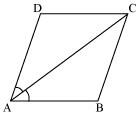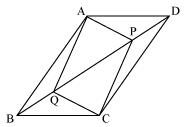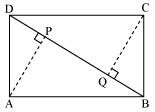Quadrilaterals
If the diagonals of a parallelogram are equal, then show that it is a rectangle.
Let ABCD be a parallelogram. To show that ABCD is a rectangle, we have to prove that one of its interior angles is 90º.
In ΔABC and ΔDCB,
AB = DC (Opposite sides of a parallelogram are equal)
BC = BC (Common)
AC = DB (Given)
∴ ΔABC ≅ ΔDCB (By SSS Congruence rule)
⇒ ∠ABC = ∠DCB
It is known that the sum of the measures of angles on the same side of transversal is 180º.
∠ABC + ∠DCB = 180º (AB || CD)
⇒ ∠ABC + ∠ABC = 180º
⇒ 2∠ABC = 180º
⇒ ∠ABC = 90º
Since ABCD is a parallelogram and one of its interior angles is 90º, ABCD is a rectangle.
Sponsor Area
Some More Questions From Quadrilaterals Chapter
The angles of quadrilateral are in the ratio 3: 5: 9: 13.
Find all the angles of the quadrilateral.
If the diagonals of a parallelogram are equal, then show that it is a rectangle.
Show that if the diagonals of a quadrilateral bisect each other at right angles, then it is a rhombus.
Show that if the diagonals of a quadrilateral are equal and bisect each other at right angles, then it is a square.
Diagonal AC of a parallelogram ABCD bisects ∠A (see the given figure). Show that
(i) It bisects ∠C also,
(ii) ABCD is a rhombus.

ABCD is a rhombus. Show that diagonal AC bisects ∠A as well as ∠C and diagonal BD bisects ∠B as well as ∠D.
In parallelogram ABCD, two points P and Q are taken on diagonal BD such that DP = BQ (see the given figure).

Show that:
(i) ΔAPD ≅ ΔCQB
(ii) AP = CQ
(iii) ΔAQB ≅ ΔCPD
(iv) AQ = CP
(v) APCQ is a parallelogram
ABCD is a parallelogram and AP and CQ are perpendiculars from vertices A and C on diagonal BD (See the given figure). Show that

(i) ΔAPB ≅ ΔCQD
(ii) AP = CQ
Mock Test Series
Sponsor Area
NCERT Book Store
NCERT Sample Papers
Sponsor Area